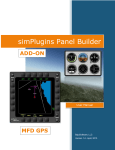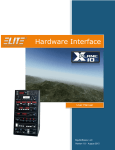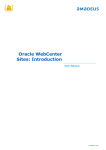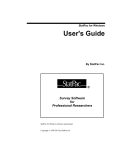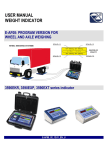Download simPlugins Panel Builder
Transcript
simPlugins Panel Builder User Manual BajuSoftware, LLC Page 1 of 42 Version 2.9 – August 2015 Panel Builder User Manual Table of Contents Introduction.................................................................................................................................. 3 Capabilities and Features ............................................................................................................. 4 Technical Requirements ............................................................................................................... 6 Licensing ..................................................................................................................................... 7 Licensing for HOME Download Version ........................................................................................ 8 Step 1 – Requesting an Activation Code ...................................................................... 10 Step 2 – Entering the Activation Code ......................................................................... 11 Integration Scenarios ................................................................................................................. 12 Single Computer – Single or multiple Monitors ............................................................. 12 Two computers - Single or multiple monitors ............................................................... 13 Multiple computers - Single or multiple monitors ......................................................... 14 Installation Procedures ............................................................................................................... 15 Step 1 – Install Panel Builder Installer .......................................................................... 16 Step 2 – Install Panel Builder Modules ......................................................................... 19 Step 3a - Network Configuration .................................................................................. 20 Step 3b - Interface Configuration ................................................................................. 22 Step 3c – Condor Configuration ................................................................................... 23 Step 3d – Panel Builder Configuration .......................................................................... 24 Operation .................................................................................................................................. 26 Launching a Panel ....................................................................................................... 27 Stopping a Panel ......................................................................................................... 27 Display on Desktop ...................................................................................................... 27 Building Panels .......................................................................................................................... 28 Modifying an existing panel ......................................................................................... 29 Adding an instrument .................................................................................................. 29 Removing an instrument from the panel ...................................................................... 30 Moving and Resizing an Instrument in a panel ............................................................ 30 Modifying an instrument .............................................................................................. 31 Adding a new panel ..................................................................................................... 32 Modifying a panel ........................................................................................................ 34 Deleting a panel........................................................................................................... 34 Tips and Tricks ............................................................................................................ 35 Instrument Reference ................................................................................................................. 36 Copyright © 2015, BajuSoftware, LLC. All rights reserved. Page 2 of 42 Panel Builder User Manual Introduction Panel Builder is an add-on Avionics Package that allows the creation of custom Instrument Panels to interface with several Flight Simulator Programs. Typically instrument panels are displayed on a separate monitor in full-screen mode. A mask can be used to cover unused portions of the monitor to more closely resemble a typical instrument panel Panel Builder can be run on the same computer as the flight simulator software. It is recommended thought to utilize one or more additional computers for this purpose for performance reasons. Each instrument is ‘free floating’ in the screen. It can be resized, moved around the screen and combined into a predefined panel. For the latter purpose, a management tool called Panel Builder is provided. Panel Builder allows the building of instrument panels for different aircraft types and provides a mechanism for starting and stopping all instruments. Some instruments contain configuration options that are accessible via a right click menu option. This is used for setting ranges and/or color bars on the instrument, calculations and performance related options. This allows using the same instrument for a slow piston powered airplane or a high performance turbine powered airplane. The same instrument can be used multiple times in a panel. This allows for example to build panels for multi-engine aircraft or for defining a pilot and co-pilot instrument panel. Copyright © 2015, BajuSoftware, LLC. All rights reserved. Page 3 of 42 Panel Builder User Manual Capabilities and Features Multiple Flight Simulators supported. Currently supported are X-Plane (V9.0 and above), MS Flight Simulator X (Acceleration), MS Flight Simulator 2004, Lockheed Martin Prepar3D (1.2 or greater) and Condor Soaring Simulator Interface software is supplied depending on version purchased. The same Panel can be used with all supported Flight Simulators. Modular Design Instruments (Panel Builder) and Interface software are separate modules. This enables adding new interfaces for other flight simulators without changing the instrument software. The interface software is always installed in the same computer as the flight simulator. The instruments (Panel Builder) can be installed on separate, networked computers. Vector based Instruments Allows the sizing of instrument to match a cut-out mask or to set them to the required size for easy reading. No images are used to draw instruments on the screen. Instruments are always crisp and easy to read in any size. Network support Panel Builder is typically installed on one or more additional, networked computers. This will lower the performance impact the external panel has on the flight simulation software. It also provides additional screen real estate for the panels. Interface Configuration Each Flight Simulator Interface can be fully configured to allow for customization and enabling the support of new flight simulator features in the future. Instruments 12 Soaring Instruments are included. Additional instruments can be added as they become available. Copyright © 2015, BajuSoftware, LLC. All rights reserved. Page 4 of 42 Panel Builder User Manual ‘Free-floating’ Instruments All instruments provided can be moved anywhere on a monitor. This allows accurate placement of instruments on a predefined back-ground graphic or cut-out mask. They can be locked in place to avoid accidental moving. ‘Free-sizing’ Instruments All instruments can be resized in fine increments. This is useful to fit instruments into a panel mask Configurable Instrument Ranges Instruments can be configured to match the aircraft’s performance data. This configuration allows the use of all instruments in different aircraft types. The configuration is stored within an instrument for a specific panel. Multiple-use Instruments Each instrument can be used multiple times within the same panel. This allows the use of engine instruments for multi-engine aircraft and to design a pilot and co-pilot panel. Commercial Applications The Commercial version licenses the user to deploy Panel Builder in a commercial environment and for resale as part of a complete flight simulator environment. Each deployment does require the purchase of a separate license. Copyright © 2015, BajuSoftware, LLC. All rights reserved. Page 5 of 42 Panel Builder User Manual Technical Requirements Hardware Operating Software Flight Simulator Processor Memory Disk Space Any Dual Core Processor or greater 4GB (32 Bit), 8GB (64 Bit) 1 GB (approx.) Windows Vista Windows 7 Windows 8 Windows 10 MS Flight Simulator X MS Flight Simulator 2004 Condor 32 or 64 Bit 32 or 64 Bit 32 or 64 Bit 32 or 64 Bit Acceleration or SP2 Any version 1.1.2 or greater Copyright © 2015, BajuSoftware, LLC. All rights reserved. Page 6 of 42 Panel Builder User Manual Licensing Panel Builder comes in three versions, Home Version , Academic Version and Commercial Version. The Home Version is intended for home use only, which means that you can use Panel Builder on your home network only. The Commercial Version is intended for commercial applications. The Commercial Version is typically used for integration into commercial Flight Simulators, Flight Training, to be shown at Exhibitions and Shows and other commercial applications. In general, any use that is outside of the home requires a Commercial License. The Academic Version is like the Commercial Version but is limited to educational Institutions like colleges. All versions are distributed using the same Installation Package and each version is enabled by a different activation scheme. Both versions are delivered on an USB Memory stick and the memory stick has to stay plugged in on the computer where Panel Builder is installed on. Replacement USB sticks can be ordered. The Home Version has also an alternate licensing scheme via an Activation Code. This licensing is used when you purchase a download version of Panel Builder. Licensing is activated by requesting an activation code via E-Mail. An installation code has to be sent and an activation code is returned. Panel Builder provides a facility to enter this activation code. See next chapter for more information. If Panel Builder is started and neither a USB stick nor Activation code is present, the software reverts to Demo Mode. Demo Mode has the following restrictions: No new panel can be built Only 6 instruments can be added to the existing panel The runtime is limited to 10 Minutes. Demo Mode is clearly indicated on the Panel Builder Main Screen To return to a licensed mode, either a valid USB Memory stick has to be plugged in, or an activation code has to be entered. Panel Builder needs to be restarted in both cases. Copyright © 2015, BajuSoftware, LLC. All rights reserved. Page 7 of 42 Panel Builder User Manual Licensing for HOME Download Version When Panel Builder starts the first time after installation, the license is checked. The following message appears if no license is found: Click on the [Yes] button. Then select Configuration and Enter Activation Code from the menu. The following information is displayed: Activation requires a serial number that you should have received from your reseller. If you do not have received this serial number, contact your reseller. Click on [OK]. Copyright © 2015, BajuSoftware, LLC. All rights reserved. Page 8 of 42 Panel Builder User Manual Licensing is a 2 step process. First you request an activation code, and then you enter the received code. Requesting an activation code is done automatically if connected to the Internet or manually via E-Mail. The activation code is returned to you via E-Mail. Each Activation Code is unique and is registered to the Serial Number, your E-Mail Address and the Computer you have Panel Builder Installed on. The Activation allows for unlimited re-installs on the same computer. If you have a new computer and install Panel Builder, use the same activation code you have received. There are limited numbers of reactivations for new computers. Once you reach the limit, you will receive an e-mail explaining what to do in this case. Copyright © 2015, BajuSoftware, LLC. All rights reserved. Page 9 of 42 Panel Builder User Manual Step 1 – Requesting an Activation Code Enter your E-Mail Address and Serial Number then click on [Request Activation Code]. The following message appears. You have 2 options, either click on [Request Now]. This will send the request directly. Or if you are not connected to the Internet, make a note of your E-Mail Address, the Install Code and the Serial Number as displayed and send an email to the e-mail address shown on the form. Click on [Done] and [Done] again. You can use Panel Builder in Demo mode until you receive the activation code. Copyright © 2015, BajuSoftware, LLC. All rights reserved. Page 10 of 42 Panel Builder User Manual Step 2 – Entering the Activation Code Once you receive your Activation Code via e-mail, start Panel Builder and click [Yes] on the License check screen. This time enter the received Activation Code under Step 2 and click the Activate Button. You will receive a message that the license has been generated. If you made a mistake entering the code, the next time Panel Builder starts, you might get the following message: Click in the [OK] Button and re-enter the code in the Configuration Menu under ‘Enter Activation Code’ Copyright © 2015, BajuSoftware, LLC. All rights reserved. Page 11 of 42 Panel Builder User Manual Integration Scenarios This section describes different scenarios Panel Builder can be used with. Each scenario requires different installation procedures and network configuration. There are three distinct scenarios. The number of monitors attached on a computer does not affect any installation or configuration options if the multiple monitors are configured to expand the desktop area (virtual desktop across multiple monitors). Single Computer – Single or multiple Monitors Diagram Computer 1 – Flight Simulator & Instruments Module Selection Computer Flight Simulator Installed Panel Builder Modules Required Computer 1 Condor Condor Interface Panel Builder Copyright © 2015, BajuSoftware, LLC. All rights reserved. Page 12 of 42 Panel Builder User Manual Two computers - Single or multiple monitors Diagram Computer 1 – Flight Simulator Computer 2 - Instruments Module Selection Computer Flight Simulator Installed Panel Builder Modules Required Computer 1 Condor Condor Interface Computer 2 - Panel Builder Copyright © 2015, BajuSoftware, LLC. All rights reserved. Page 13 of 42 Panel Builder User Manual Multiple computers - Single or multiple monitors Diagram Computer 1 – Flight Simulator Computer 2 – Instruments Pilot Computer 3 – Instruments Co-Pilot or Instructor Module Selection Computer Flight Simulator Installed Panel Builder Modules Required Computer 1 Condor Condor Interface Computer 2 - Panel Builder Computer 3 - Panel Builder Note: Running Panel Builder on multiple computers requires a license for each computer you are running Panel Builder on. Copyright © 2015, BajuSoftware, LLC. All rights reserved. Page 14 of 42 Panel Builder User Manual Installation Procedures Panel Builder is installed using a 3 step process. The installer software is installed first which allows the selection of the different modules to be installed on each computer (or on a single computer). The different modules are: Panel Builder Condor Interface Depending on the Flight Simulator you are using, choose the appropriate interface module in Step 2. Step 1 Install the Panel Builder Install package on each computer that will be part of the overall Flight Simulator System. If you are installing from the supplied license USB Key, you can run the installer directly on the USB Key and can skip this step. Locate the USB key in Windows Explorer and doubleclick on PanelBuilderInstaller Step 2 Run the Panel Builder Installer on each computer and choose which modules should be installed on each computer. The selection of modules is dependent on the integration scenario applicable to your simulator system as described in the previous chapter. Step 3 (Optional) Configure each module of Panel Builder for: Networking Performance This step is optional. All modules have been preconfigured (even the networking!) and no changes are necessary. Copyright © 2015, BajuSoftware, LLC. All rights reserved. Page 15 of 42 Panel Builder User Manual Step 1 – Install Panel Builder Installer Skip this step if you run the installer from the supplied USB Key Copy the installation package to each computer that is part of your flight simulation system. Start the installation program on each computer by locating the installation program and double click it. This will launch the installation. Click the [Next >] button. This specifies where the install packages will be installed to. Click [Next >]. Copyright © 2015, BajuSoftware, LLC. All rights reserved. Page 16 of 42 Panel Builder User Manual Here you have the option to create a Start Menu folder, or click on ‘Don’t create…’ Click on [Next >] Here you can specify to create any icons for the installer. Click [Next >] Copyright © 2015, BajuSoftware, LLC. All rights reserved. Page 17 of 42 Panel Builder User Manual Review your chosen options, then click on [Install]. Wait for the install to finish. The installation has finished, click on the [Finish] button. Copyright © 2015, BajuSoftware, LLC. All rights reserved. Page 18 of 42 Panel Builder User Manual Step 2 – Install Panel Builder Modules On each computer that is part of your flight simulation system, launch the Panel Builder Installer and select the module(s) from the list as appropriate for the computer. See the Integration Scenarios chapter for a recap what is required on each computer for each scenario. When selecting a module from the left side, the right side will show a short description and will also contain a button to start the install for the module selected. Proceed now to install the module(s) required on each computer. Afterwards, click on the Exit icon on the left. Go to section Operation on how to us it. You can skip the network configuration. There is no need to change any values; the defaults should work in 99% of all installations. Copyright © 2015, BajuSoftware, LLC. All rights reserved. Page 19 of 42 Panel Builder User Manual Step 3a - Network Configuration All modules of Panel Builder communicate using a network protocol. The Interface software receives data from the flight simulator and sends the appropriate data to each instrument, either on the same computer or to additional computers. Even if both the flight simulator software and Panel Builder is installed on the computer, communication is still performed using the network protocol. Each Flight Simulator Interface and Panel Builder has a configuration screen for setting networking parameters. Following the scenarios described in previous chapters, each scenario has a different network configuration. Furthermore, network configuration requires also port numbers for each component of Panel Builder, including Instruments. Port Numbers use a default setting after installation of Panel Builder and will not need to be changed in most cases. There are circumstances were a port number is already in use by a different program than Panel Builder. In this case the port number will need to be changed to a different value. In summary, there is no network configuration necessary after the installation. All components of Panel Builder have been preset and those values should work for 99% of all installations. The following pages are for your information and in the rare case where you need to make changes to the network. What is a Multicast Group Address? A Multicast Group Address is a special IP Address that has been reserved for performing communications between groups of programs. It works like a subscription where all programs wanting to communicate with each user subscribe to the same Group Address. In order to support more than one instrument computer and to allow multiple use of an instrument in the same panel, the multicast broadcasting scheme is used. A Multicast Group Address has to be set in the flight simulator interface programs and Panel Builder. The Multicast Group Address is an address that all parts of Panel Builder communicate through on your network. The Multicast Group Address is the same for all Interfaces and Panel Builder. There is a fixed range of valid addresses. They are in the range between 224.0.0.0 and 239.255.255.255 Panel Builder and all Interfaces have been preset to 224.11.5.62. This does not need to be changed unless you have another program using this address, which is highly unlikely. Copyright © 2015, BajuSoftware, LLC. All rights reserved. Page 20 of 42 Panel Builder User Manual Changing the Multicast Group Address – Write down your value. Computer Default Multicast Group Address 224.11.5.62 Your Value This address needs to match in each module of Panel Builder, the Interfaces and Panel Builder itself. The address has to be in the range of 224.0.0.0 and 239.255.255.255 . Choose any address within the valid range and make a note of it above. Continue in the next chapters with Interface Configuration and Panel Builder Configuration. Changing Port Numbers – Default values are shown. Typically use those values. If you need to change them, make a note in the last column Module Name Panel Builder Listen Port Default Port Number 48000 Condor Interface Receive Listening Port 55278 Your Port Number Instrument Port Numbers are listed in the Instrument Reference Section of this manual. Continue with the next chapter to configure all modules of Panel Builder and refer back to both tables above to help with the configuration. Copyright © 2015, BajuSoftware, LLC. All rights reserved. Page 21 of 42 Panel Builder User Manual Step 3b - Interface Configuration Configure the Condor Interface There is no need to change any values; the defaults should work in 99% of all installations. Launch the simPluginsCondor program. Click on the [Network Configuration] Button. Multicast Group Address is the broadcast IP address of the network of your flight simulator system. (Default: 224.11.5.62) Listen Port (from Condor) specifies the port number the simPluginsCondor Interface ‘listens’ on. This setting has to match what has been configured in the Condor configuration file UDP.ini Panel Builder Port is the Listening Port for all Instruments. AutoConnect means that whenever simPluginsCondor is started, it will connect automatically. Click on [Save] to save the settings. Copyright © 2015, BajuSoftware, LLC. All rights reserved. Page 22 of 42 Panel Builder User Manual Step 3c – Condor Configuration Condor has to be configured to export flight values. This is done in the file UDP.ini. The file is typically located in C:\Program Files (x86)\Condor Open the file with any text editor and make the following changes: Set Set Enabled=1 SendIntervalMS=100 Make a note at the Port number. This port number has to match what has been configured in the simPluginsCondor program under Listen Port (from Condor). Now save the file. Copyright © 2015, BajuSoftware, LLC. All rights reserved. Page 23 of 42 Panel Builder User Manual Step 3d – Panel Builder Configuration There is no need to change any values; the defaults should work in 99% of all installations. Start Panel Builder and select the Configuration tab. Changing the Network Configuration Multicast Group Address The Multicast Group Address (default 224.11.5.62) can be left as is. It has to match all other Multicast Group Addresses configured. Listen Port No This is the port number Panel Builder will use when receiving data. The default is 48000. Not used with Condor. Flight Sim Port No This number has to match the Port Number as configured in the flight simulator interface application. The default is 45000. See also chapter Interface Configuration Not used with Condor. Copyright © 2015, BajuSoftware, LLC. All rights reserved. Page 24 of 42 Panel Builder User Manual Help The help section has shortcuts to the User Manual, License Information and the simPlugins website for your reference. Copyright © 2015, BajuSoftware, LLC. All rights reserved. Page 25 of 42 Panel Builder User Manual Operation After installation, you should have an icon for ‘Panel Builder Condor’ on your desktop where you installed the instruments on. Double click it. This will launch the Panel Builder Program that allows you to Start and Stop all Instruments for a panel Build new panels Set the IP Address and Port Number to connect to the flight simulator interface Select the Operation tab. By default, the last panel used will be loaded automatically. This display shows what instruments are part of the panel and their associated Port Numbers. Those port numbers match the Instrument Interface Configuration for the specific instrument. Copyright © 2015, BajuSoftware, LLC. All rights reserved. Page 26 of 42 Panel Builder User Manual Launching a Panel Select a panel by clicking the Load Panel icon and selecting a panel from the list. Click on the Start button. All shown instruments that have a checkmark next to them will be started and shown on computer screen and the Panel Builder program will be minimized. Each Instrument’s position is saved with the panel configuration. You can re-locate an Instrument by simply dragging it to a new position on the screen. There is a facility to ‘lock’ the instruments to the position to avoid accidentally moving it. Right Click on the instrument and a menu will be shown. Click on ‘Lock’ to toggle the lock/not locked option. Now you can start your flight simulator and your instruments should come alive! Note: Once started, you cannot make any changes to the panel configuration. You need to stop it first. Note: You also need to click on the [Connect] button in the simPluginsCondor program on your flight simulator computer to establish a connection to Condor. Stopping a Panel As mentioned previously, when a panel is started the Panel Builder program is minimized to the task bar. Click on the minimized icon and it will show again. Now click the STOP button. Display on Desktop All instruments are separate programs that will show on your desktop. The Panel Builder program will hide the windows desktop, set the background image or the background color as configured for each panel. (See the Building Panels section) and suspend the screen saver if used. Copyright © 2015, BajuSoftware, LLC. All rights reserved. Page 27 of 42 Panel Builder User Manual Building Panels Multiple panels can be configured for different aircraft types. Each panel configuration contains Name of the panel (e.g. the aircraft type) A background Image or a Background Color Instruments included in panel Position and size of each instrument on the screen. Reset the position of an instrument to the top left corner of the 1st Monitor Select the Building tab. Copyright © 2015, BajuSoftware, LLC. All rights reserved. Page 28 of 42 Panel Builder User Manual Modifying an existing panel Choose a panel by clicking the Open Panel icon under the operation tab and select a panel from the list. The click on the Building tab. Adding an instrument Click on Add Instrument. The window as shown above will appear. All available Instruments are shown on the right side. Scroll through the list until you locate the required instruments. You can also filter instruments by instrument type by selecting the appropriate section in the box labeled Instrument Type. Note: The list of available instruments depends on what version of Panel Builder you have. Copyright © 2015, BajuSoftware, LLC. All rights reserved. Page 29 of 42 Panel Builder User Manual An image and description will be shown for each instrument. The Port Number will be filled in automatically choosing the default port of the instrument. Check each instrument to be added and click on [Add checked instruments] To set the location of an Instrument, the panel needs to be ‘started’. Click on the Start Button. (See chapter Operation for more information). All instruments initial position is in the top left corner. So it will happen that all newly added instruments sit on top of each other. Simply drag each instrument into its final position. Stop the panel and at that stage the position of each instrument is saved. To configure each instrument for the aircraft type the panel is intended for, see the chapter Instrument Reference. Removing an instrument from the panel The delete an instrument, select the instrument in the list and click on the Remove button. Moving and Resizing an Instrument in a panel Those operations require that a panel is ‘running’, i.e. the panel has been started and all instruments of the panel are displayed. By default all instruments are placed at the top left corner of the monitor. To move it to its proper location, left click and drag the instrument around the monitor. To resize and instrument left click (and release) on the instrument, then either use you mouse wheel or the [+] and [-] buttons on the numeric keypad. Note: To lock an instruments size and position, right click on the instrument and select ‘Lock’ from the menu. To un-lock, repeat the operation. Note: To reset the position of an instrument to the top left corner of the 1 st Monitor select the instrument in the instrument list of Panel Builder and choose the Building/Reset Position in the menu. Copyright © 2015, BajuSoftware, LLC. All rights reserved. Page 30 of 42 Panel Builder User Manual Modifying an instrument Select an instrument in the list and click on the Edit Settings button in the Instrument menu section. You can also double-click it. You can only modify the port number of the instrument.. Note: If you modify the port number, you also have to modify the port number in the appropriate Interface Configuration. See chapter Interface Modification. Copyright © 2015, BajuSoftware, LLC. All rights reserved. Page 31 of 42 Panel Builder User Manual Adding a new panel To add a new panel, click on the New Panel button in the Panels menu section. Panel Name: Enter the name of the panel e.g. the aircraft type. Show Instrument Bezels & Knobs. This will either show/or hide the bezels, mounting screws and any knobs for the instruments. This is useful for cockpit builders who use a mask in front of the monitor. A mask could be made from cardboard or other thin material, or if a monitor is integrated into a full instrument panel. Enable Panel Night Mode This will automatically switch all instruments in the panel to a ‘red glow’ color for night flying. The switching occurs when the time in the flight simulator switches to night time. Copyright © 2015, BajuSoftware, LLC. All rights reserved. Page 32 of 42 Panel Builder User Manual Panel Background Type: Select between colored background and an image. Color Background: Specify the color and an optional colored frame. Image Background: Specify the image file and if you want to retain the original image size of a custom size. Background Size and Position Four options are available: Full Desktop This fills the desktop area with the selected color or image. If you have multiple monitors connected it will span all monitors. One Monitor only As above, but the background will be restricted to the monitor specified. This only applies only to multi-monitor setups. Custom Size and Position Here you can specify what size and what position the background should be. This is useful if you don’t want a background that fills a whole monitor. No Background Just as the name implies. The instruments will be placed on the desktop as is. Copyright © 2015, BajuSoftware, LLC. All rights reserved. Page 33 of 42 Panel Builder User Manual Modifying a panel The panel configuration (not the instruments within a panel) can be modified using the Edit Panel button in the Panels menu section. To modify an instrument see chapter Modifying an instrument. Follow the steps as described in the Adding a new panel section. Note that the Panel Name cannot be modified! Deleting a panel To delete a panel click on the Delete Panel button in the Panels menu section. Please note that the configuration for all Instruments in that panel will also be deleted. Copyright © 2015, BajuSoftware, LLC. All rights reserved. Page 34 of 42 Panel Builder User Manual Tips and Tricks Where can I find the Panel Builder Installer? The installer is provided on a USB Key or a downloaded file. Find the drive letter of the USB Key or the download file in Windows Explorer and double click PanelBuilderInstaller.exe C:\ProgramFiles (X86)\Panel Builder Installer Condor How can I change the Banner Image on the bottom of the Panel Builder screen? There is a filed called BannerImage.jpg in the Panel Builder program Files folder. Replace this file with your own version. For correct display, create an image file with the following dimensions: 484 pixels wide by 60 pixels high. This requires the Panel Builder Commercial Version. All instruments are cut-off at the bottom right (instruments are only partially visible) Make sure that the text size is set to 100% in Windows Control Panel/ Display. Instrument XXX doesn’t update This is very likely an issue with the port number configuration. Make sure that both port numbers are the same in Panel Builder and the Instrument Interface. Where can I set the instrument ranges and color arcs? Each instrument has a menu that can be accessed by right-clicking on an instrument and selecting the Settings options. Not all instruments have a settings option. I accidentally move Instruments when using the knobs. Each instrument can be locked into its position by right-clicking on the instrument and selecting Lock. Copyright © 2015, BajuSoftware, LLC. All rights reserved. Page 35 of 42 Panel Builder User Manual Instrument Reference To display the settings window for each instrument, right click with your mouse on the instrument and then select Settings. To change the size, use the scroll wheel on the mouse or the [+]/[-] keys on the numeric keypad. Instrument Airspeed Indicator Knots Settings Defaults Port Number: 41000 Airspeed Indicator Km/h Copyright © 2015, simPlugins. All rights reserved. Port Number: 41000 Page 36 of 42 Panel Builder Instrument User Manual Settings Defaults Altimeter Port Number: 41000 Artificial Horizon Port Number: 41000 Copyright © 2015, BajuSoftware, LLC. All rights reserved. Page 37 of 42 Panel Builder Instrument User Manual Settings Defaults Turn Coordinator Port Number: 41000 Variometer Port Number: 41000 Copyright © 2015, BajuSoftware, LLC. All rights reserved. Page 38 of 42 Panel Builder Instrument User Manual Settings Defaults E Variometer Port Number: 41000 G Meter Port Number: 4100 Copyright © 2015, BajuSoftware, LLC. All rights reserved. Page 39 of 42 Panel Builder Instrument User Manual Settings Defaults Compass Port Number: 4100 COM Radio Port Number: 4100 Copyright © 2015, BajuSoftware, LLC. All rights reserved. Page 40 of 42 Panel Builder Instrument User Manual Settings Defaults Chronometer Port Number: 4100 Analog Clock Port Number: 4100 Copyright © 2015, BajuSoftware, LLC. All rights reserved. Page 41 of 42 Panel Builder User Manual simPlugins Panel Builder Condor Edition User Manual Version 2.9 Copyright © 2013, BajuSoftware, LLC. All Rights reserved. No reproduction without permission Copyright © 2015, simPlugins. All rights reserved. Page 42 of 42











































